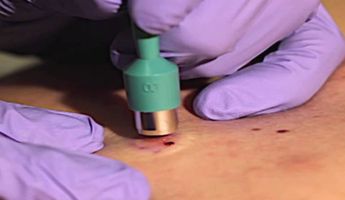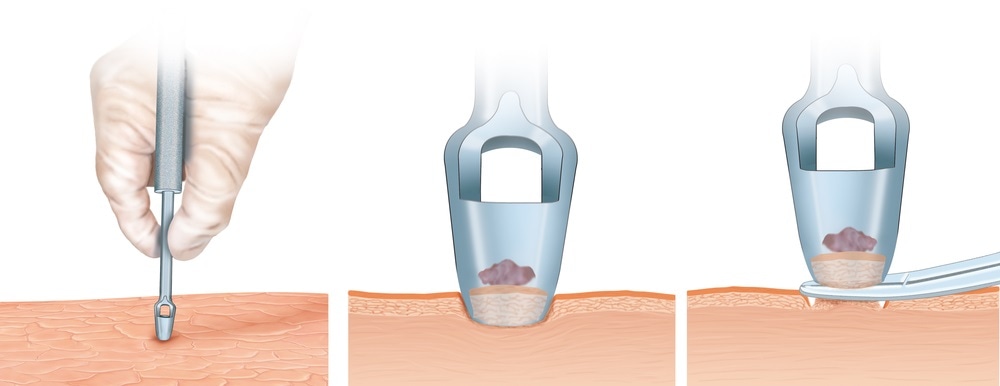Skin Biopsy in Cyprus
Search and Compare the Best Clinics and Doctors at the Lowest Prices for Skin Biopsy in Cyprus

Find the best clinics for Skin Biopsy in Cyprus
No clinics available
Ukraine offers the best prices Worldwide
Price: $ 106

- Home
- Cyprus
WHY US?
At Medijump, we're making medical easy. You can search, compare, discuss, and book your medical all in one place. We open the door to the best medical providers worldwide, saving you time and energy along the way, and it's all for FREE, no hidden fees, and no price markups guaranteed. So what are you waiting for?

Free

Best Price

Widest Selection

Risk-Free
What you need to know about Skin Biopsy in Cyprus

A skin biopsy is a procedure in which cells or skin samples are removed from the surface of the body to be tested. The sample taken from a skin biopsy is sent to a laboratory and examined by a pathologist under a microscope. By looking at the sample, the pathologist can diagnose or rule out skin cancer. In some cases, it can also be used to remove skin lesions.
A skin biopsy is needed to diagnose or to help treat skin conditions and diseases, including skin infection, warts, actinic keratosis, skin tags, suspicious moles or other growths, blistering skin disorders (such as bullous pemphigoid), inflammatory skin conditions (such dermatitis and psoriasis), and skin cancers (including melanoma, squamous cell carcinoma, and basal cell carcinoma).
What does the Procedure Involve?
Before the procedure, your doctor cleans the area of the skin to be biopsied. Your skin may be marked to outline the biopsy area. You will then be given a local anaesthetic to numb the biopsy site.
How your doctor performs the procedure depends on the type of biopsy.
-
Shave biopsy – during this type of biopsy, your doctor uses a sharp tool, scalpel or double-edged razor to remove a small section of the top layers of your skin (epidermis and a portion of the dermis).
-
Punch biopsy – your doctor uses a circular instrument called a punch in order to remove a small section of your skin, including the deeper layers (epidermis, dermis, as well as superficial fat).
-
Excisional biopsy – your doctor uses a small scalpel in order to remove an area of abnormal skin, which includes a portion of normal skin down to the fatty layer of skin. This type of biopsy can also be done to remove an entire lump, usually smaller lesions.
-
Incisional biopsy – a scalpel is used to remove a small sample of large lesions.
While a shave biopsy usually does not need stitches, punch biopsy, excisional biopsy, and incisional biopsy usually require stitches to close the wound as they involve cutting into the uppermost layer of fat underneath the skin.
How Long Should I Stay in Cyprus?
A skin biopsy usually takes around 15 minutes to complete. It is an outpatient procedure, so you can leave the hospital on the same day as your skin biopsy. However, since the results are available within several days or weeks, you need to stay in Cyprus for at least 7 days following your biopsy. Once the result is available, you will need to attend a follow-up visit to discuss the results of the test with your doctor.
What's the Recovery Time?
In general, you should rest as much as possible for the remainder of the day and go back to your normal activities the day after. However, you need to take it easy and avoid vigorous activities for a few days to avoid complications. How long it takes your biopsy site to heal depends upon the depth and size of the biopsy, which may take about 2 to 3 weeks.
What About Aftercare?
Following the biopsy, your doctor will give you aftercare instructions. Follow the instructions carefully for a quick and smooth recovery. You may experience some soreness on or around the biopsy site for a few days, but you can take Tylenol to relieve any discomfort. If you have stitches, make sure to keep the area clean. Try not to do any activities that might stretch the skin as it could enlarge the scar and cause the wound to bleed.
What's the Success Rate?
A skin biopsy is a safe and accurate method to diagnose skin conditions and diseases. The accuracy of a shave biopsy is 97%, while a punch biopsy is shown to be 85% accurate. The result of a skin biopsy is highly dependent on the quality of the biopsy submitted. It is possible to miss the diagnosis of a skin tumour.
The result of your skin biopsy will include a diagnosis and a description of the skin condition. If the sample is found to be cancerous, the description will include information about how quickly the cancer cells are dividing, the thickness and margins of the tumour, the presence of tiny tumours near the main tumour, as well as invasion of the tumour into a nerve, blood vessel, or lymph vessel.
While a skin biopsy is a generally safe procedure, complications can still occur. These include bleeding, bruising, infection, scarring, and allergic reaction to the anaesthesia.
Are there Alternatives to Skin Biopsy?
A skin biopsy is needed to diagnose and treat skin conditions and diseases. There are currently no other alternatives to diagnose skin cancer and other serious skin conditions.
What Should You Expect Before and After the Procedure
Before a skin biopsy, your doctor may not know for sure the skin condition or disease you have. After the biopsy, your doctor will be able to diagnose or rule out skin cancer. This allows them to help create a treatment plan for you. If your doctor removed an entire lesion, then the biopsy may have also cured cancer.
Whilst the information presented here has been accurately sourced and verified by a medical professional for its accuracy, it is still advised to consult with your doctor before pursuing a medical treatment at one of the listed medical providers
No Time?
Tell us what you're looking for and we'll reachout to the top clinics all at once
Enquire Now

Popular Procedures in Cyprus
Prices Start From $4

Prices Start From $11

Prices Start From $53

Prices Start From $6,002

Recommended Medical Centers in Cyprus for procedures similar to Skin Biopsy

- Interpreter services
- Translation service
- Religious facilities
- Medical records transfer
- Medical travel insurance
- Health insurance coordination
- TV in the room
- Safe in the room
- Phone in the room
- Private rooms for patients available

- Interpreter services
- Translation service
- Religious facilities
- Medical records transfer
- Medical travel insurance
- Health insurance coordination
- TV in the room
- Safe in the room
- Phone in the room
- Private rooms for patients available

- Interpreter services
- Translation service
- Religious facilities
- Medical records transfer
- Medical travel insurance
- Health insurance coordination
- TV in the room
- Safe in the room
- Phone in the room
- Private rooms for patients available

- Interpreter services
- Translation service
- Religious facilities
- Medical records transfer
- Medical travel insurance
- Health insurance coordination
- TV in the room
- Safe in the room
- Phone in the room
- Private rooms for patients available

- Interpreter services
- Translation service
- Religious facilities
- Medical records transfer
- Medical travel insurance
- Health insurance coordination
- TV in the room
- Safe in the room
- Phone in the room
- Private rooms for patients available

- Interpreter services
- Translation service
- Religious facilities
- Medical records transfer
- Medical travel insurance
- Health insurance coordination
- TV in the room
- Safe in the room
- Phone in the room
- Private rooms for patients available

- Interpreter services
- Translation service
- Religious facilities
- Medical records transfer
- Medical travel insurance
- Health insurance coordination
- TV in the room
- Safe in the room
- Phone in the room
- Private rooms for patients available

- Interpreter services
- Translation service
- Religious facilities
- Medical records transfer
- Medical travel insurance
- Health insurance coordination
- TV in the room
- Safe in the room
- Phone in the room
- Private rooms for patients available
Skin Biopsy in and around Cyprus
Cyprus is an island country in the Mediterranean Sea. The country is famous for its mineral wealth, splendid wines, dazzling beaches, and compelling culture. In addition, Cyprus is filled with classical ruins and century-old monasteries, and as the legendary birthplace of Aphrodite, it is also steeped in mythology. Due to its huge array of modern private medical centers equipped with excellent service, cutting-edge technology, and skilled doctors, Cyprus is also a thriving medical tourism destination. Foreign patients from all around the globe come to this country for a vast range of medical treatments, particularly bariatric surgery, cardiology, cosmetic and plastic surgery, and fertility treatments. Its spa and well-being resorts are also welcoming an increasing number of international medical tourists.
Popular Parts of Cyprus
The majority of tourists start their trip to Cyprus in Larnaca, it is the oldest city in Cyprus. It has a vast array of historical monuments, including Ayios Lazaros (the Church of Saint Lazarus), Stavrovouni Monastery, and Larnaca Medieval Castle. Besides its ancient buildings, Mackenzie Beach and Larnaca Marina are also popular among tourists. Not too far from Larnaca is Paphos, a charming city with exquisite natural beauty and all sorts of ancient ruins. The most popular attractions in this city include the Tombs of the Kings, the Old Town, Early Christian Basilica-St Paul’s Pillar, and Paphos UNESCO Archaeological Park. Nicosia, Cyprus’ capital, is also a popular destination.
Weather and Climate in Cyprus
Cyprus experiences a Mediterranean climate with four seasons and over 300 days of sunshine a year. The summer is long, warm, and dry, lasting from mid-May to mid-October. The winter starts in December and ends in February, bringing mild temperatures and more rain showers. Autumn and spring are short, but there is good weather.
Getting around in Cyprus
The main international gateway to Cyprus is Larnaca International airport. It serves international flights to many cities around Europe and the Middle East, including Kyiv, Abu Dhabi, London, and Moscow. In the south, the intercity bus system is reliable and great, but in the north, the bus services are often unreliable and do not seem to follow a timetable. Taxis are a safe and relatively inexpensive option. In the south, there are three types of taxi services: urban, trans-urban or interurban (shared and can be booked), and rural. In the north, taxis are only available in the main towns. Inside towns, buses are the best way to get around for those looking for a more affordable option. Taxis are more expensive, but they do offer more flexibility.
Tourist Visas in Cyprus
Nationals of EU countries, the United States, Australia, Canada, Britain, Iceland, Japan, and several other countries do not need a visa to visit and stay in Cyprus for up to 90 days. Other countries not listed in the visa-free agreement need to apply for a visa before entering Cyprus. It is best to consult the Cypriot Ministry of Foreign Affairs or contact the embassy to learn more about visa requirements.
Additional Information
- Local Currency: The euro (€) has been the official currency of Cyprus since 1 January 2008. The exchange rate from €1 is approximately US$1.17.
- Money & Payments: It is easy to find reliable ATMs in large towns and tourist areas. Major credit cards, such as Visa and MasterCard, are widely accepted in larger restaurants, shops, and hotels. However, if you plan to go to smaller towns or villages, it is best to ensure you have cash. Tipping is expected most of the time. Tip at least 10% of the bill, and at least 5% or round up to the nearest euro for taxi drivers.
- Local Language: Around 80% of Cypriots speak Greek as their first language, while Turkish is spoken by 10% of the population. English is widely spoken, especially in tourist areas.
- Local Culture and Religion: The main religion of Cyprus is Greek Orthodox, but Islam is the most prominent religion in the north.
- Public holidays: Some of the most celebrated holidays in Cyprus include Ohi Day, Christmas Day, Boxing Day, New Year’s Day, Epiphany, Clean Monday, Cyprus National Day, and Independence Day.
Popular Searches
- Plastic Surgery in Thailand
- Dental Implants in Thailand
- Hair Transplant in Thailand
- Breast Augmentation Thailand
- Gastric Sleeve in Thailand
- Gender Reassignment Surgery in Thailand
- Laser Hair Removal in Bangkok
- Botox in Bangkok
- Dermatology in Bangkok
- Breast Augmentation in Bangkok
- Coolsculpting in Bangkok
- Veneers in Turkey
- Hair Transplant in Turkey
- Rhinoplasty in Turkey
- Stem Cell Therapy in Mexico
- Rhinoplasty in Mexico
- Liposuction in Mexico
- Coolsculpting in Tijuana
- Rhinoplasty in Korea
- Scar Removal in Korea
- Gastric Sleeve in Turkey
- Bone Marrow Transplant in India
- Invisalign in Malaysia
- Plastic Surgery in the Dominican Republic
- Tummy Tuck in the Dominican Republic
- Plastic and Cosmetic Surgery in Poland
- Rhinoplasty in Poland
- Hair Implant in Poland
- Dental Implants in Poland
- IVF in Turkey